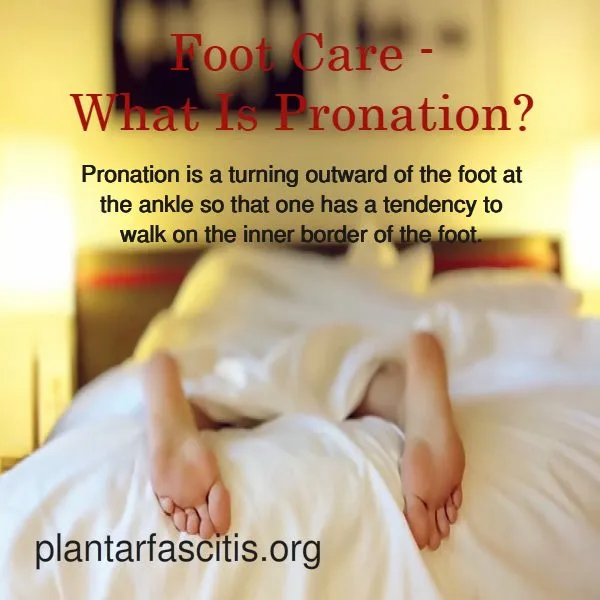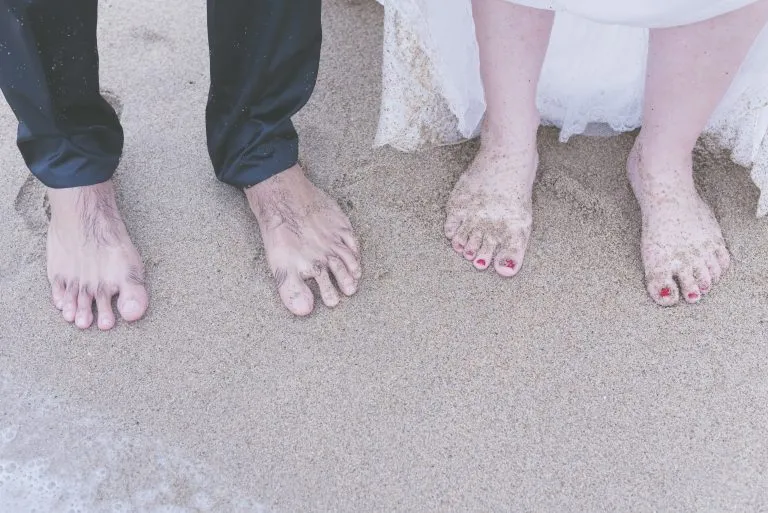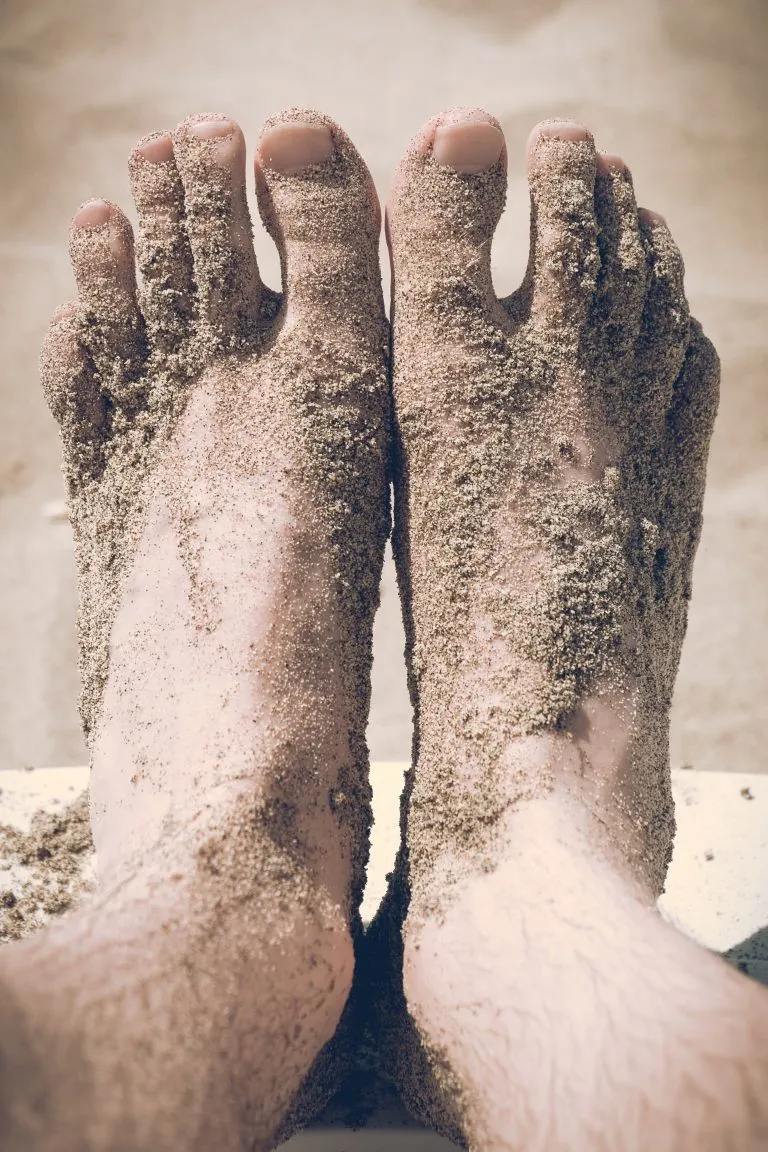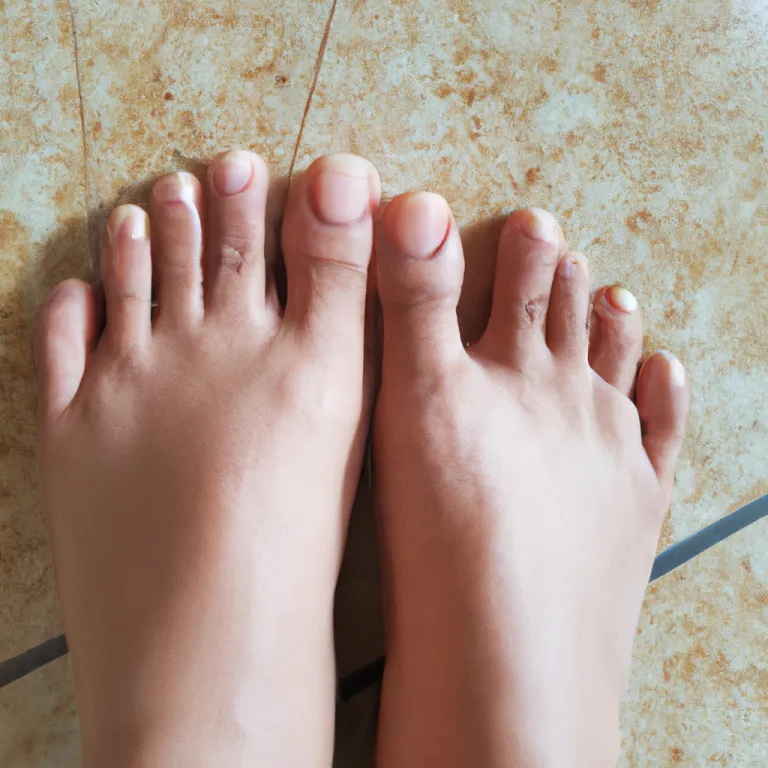Foot Care – What Is Pronation?
Pronation is a turning outward of the foot at the ankle so that one has a tendency to walk on the inner border of the foot.
When a foot and ankle pronate to a great degree, we call it overpronation. You can test for pronation by looking at the leg and foot from the back.
Usually, you can see the Achilles Tendon run straight down the leg into the heel. If the foot is pronated, the tendon will run straight down the leg, but it will twist outward when it lies on the heel.
This makes the inner ankle bone much more prominent than the outer ankle bone.
Because pronation is a foot twisting, all muscles and tendons that run from the leg and ankle into the foot will be twisted.
If left untreated, pronation may cause heel spurs, plantar fasciitis, frequent ankle sprains, shin splints, weak and painful arches, and knee, hip, and lower back pain.
Causes of Pronation:
Heredity is the most common cause of pronation — we inherit this biomechanical defect.
The second most common cause is how our feet are positioned in the uterus while developing; this is called a congenital defect. In either instance, the following occurs in our feet during our development:
The muscles, ligaments, and other soft tissue structures that hold our bones together at the joints become looser than normal.
When the bones are not held tightly in place, the joints are not aligned properly, and the foot gradually turns outward at the ankle, causing the inner ankle bone to appear more prominent.
The foot moves in this direction because it is the path of least resistance. It is more difficult for the foot to move in the opposite direction (supination).
As we develop, the muscles and ligaments accommodate this abnormal alignment.
By the time growth is complete, the pronated foot is: abnormally flexible and flat, and its outer border appears raised so that as you step down, you do not come down equally across the entire foot; instead, you come down mostly on the inner border of the foot.
Normal aging will produce further laxity of our muscles, which causes the pronation to worsen gradually.
Results of Pronation:
Due to the laxity of the soft tissue structures of the foot and the fact that the joints are not held together properly, the bones of the feet shift.
When this occurs, the muscles that attach to these bones must also shift or twist to attach to these bones. The strongest and most important muscles attached to our foot bones come from our lower leg.
So, as these muscles course down the leg and across the ankle, they must twist to maintain their proper attachments to the foot.
This twisting of these muscles will cause shin splints, Achilles Tendonitis, generalized tendonitis, fatigue, muscle aches and pains, cramps, ankle sprains, and loss of muscular efficiency (reducing walking and running speed and endurance).
The problems we see in the feet due to pronation include bunions, heel spurs, plantar fasciitis, fallen and painful arches, hammertoes, and calluses.
Treatment of Pronation:
In Children:
If pronation is diagnosed before age five, it can usually be treated so that the bones and joints will be aligned properly as growth continues.
This will prevent the arch from collapsing, as well as allow the muscles of the leg to enter the foot without twisting. With proper and early treatment, the foot will not turn out at the ankle, and the child’s gait will improve.
Treatment for pronation in children may include night braces, custom-made orthotics, and exercises. These treatments usually continue until growth is complete.
Then, the adult may need to wear custom-made orthotics to prevent the pronation from returning (the foot, like every other part of our body, tends to return to its original form if preventive measures are not taken).
One side note: pediatricians frequently wait too long, hoping the child will “outgrow” the problem.
It is too late to change the foot when they realize that the child’s feet will not improve. In these cases, custom-made orthotics prevent the pronation from worsening.
In Adults:
The only effective treatment for pronation is custom-made orthotics.
Pronationa. Pronation forces us to bear most of our weight on the inner border of our feet.
Custom-made orthotics gently redistribute the weight so that the entire foot bears its normal share of weight with each step we take. The foot will not twist out at the ankle but strike the ground, usually when orthotics are used.
This action of the custom-made orthotics will help to prevent shin splints, ankle sprains, knee and hip pain, lower back pain, nerve entrapments, tendonitis, muscle aches, bunions, generalized fatigue, hammertoes, and calluses.
Best Pronation Foot Exercises
Here are some exercises to help improve foot pronation:
- Heel Raises
- Stand straight and push down into your toes, lifting your body upward.
- Keep your abdominal muscles pulled in so you move straight upward and don’t lean forward or backward.
- Lower yourself back down.
- Repeat this 10-15 times.
- Toe Spreading
- Sit in a chair with your feet flat on the floor.
- Spread your toes apart as far as you can without straining.
- Hold the position for a few seconds, then relax.
- Repeat this 10 times.
- Foot Rolling
- Get a small ball, like a tennis ball or a frozen water bottle.
- Sit in a chair with your feet flat on the floor.
- Place the ball or bottle under one foot.
- Roll it around under your foot, applying pressure as you do so.
- Do this for a few minutes on each foot.
- Resisted Ankle Dorsiflexion
- Sit on the floor with your legs out in front of you.
- Wrap a resistance band around your foot, holding the ends in your hands.
- Keeping your leg straight, pull your foot toward your body using the resistance band.
- Repeat this 10-15 times on each foot.
- Calf Stretches
- Stand facing a wall with one foot in front of the other.
- Keep your back heel on the ground and lean forward with your front knee bent.
- You should feel a stretch in your back calf muscle.
- Hold this stretch for 30 seconds, then switch legs.
Remember to consult a health professional before starting any new exercise regimen to ensure these exercises are appropriate for you.
Custom-made orthotics support the arch as a whole and each bone and joint that forms the arch. It is not enough to use over-the-counter arch support, as these generic devices will not provide the proper support to each structure of the arch and foot.
Each pronated foot’s arch collapses differently and to different degrees.
A custom-made device is the only way to provide the support you need.
This action of the custom-made orthotic will help to prevent heel spurs, plantar fasciitis, calluses, arch pain, and weakness of the entire foot.
Custom-made orthotics will reduce the twisting of the leg muscles as they enter the foot by maintaining a normal alignment of the bones and joints.
If the bones and joints are aligned properly, by reducing the pronation, the muscles can run straight to their attachments in the foot without twisting to get to these bones.
This action of custom-made orthotics will reduce Achilles Tendonitis, shin splints, ankle, knee, hip, and lower back pain, and leg cramps.
This action will also allow the leg muscles to work more efficiently, thus allowing you to walk and run with less effort.
With every step we take, we place at least half of our body weight on each foot (as we walk faster or run, we can exert more than twice our weight on each foot).
A significant shock is passed on to our body as this weight is applied to each foot. Custom-made orthotics will absorb some of this shock, helping to protect our feet, ankles, knees, hips, and lower back.
- 【Rigid Arch Support and Angled Heel】Arch support inserts provide a more rigid shell and angled heel post to assist in a greater arch support and overpronation correction. Neutral arches naturally pronate when walking and standing, which causes the feet and ankles to roll slightly inward, adding pressure on the big toe. The orthotic inserts for women and men is a trusted solution to improve foot function, decrease arch pain and help alleviate common foot conditions caused by over pronation.
- 【Foot Pain Relief】Plantar Fasciitis Insoles for women and men can support arches and enhance stability to reduce the foot pain caused by the overstretched plantar fascia, which is suitable to prevent plantar fasciitis and correct flat feet; deep U-shaped heel design can effectively wrap the heels, maintain the correct foot positioning, reduce the risk of ankle sprain during sports! Helps ease stress and pain caused by pronation, fallen arch, Achilles Tendonitis and other foot conditions.
- 【Premium Quality & Lasting Comfort】We promise long-lasting durability and support. Our orthotics for women and men are made from built-in firm shell with a memory foam top layer and high-grade EVA foam base. Heat and friction are reduced by the soft breathable top fabric. The shoe inserts are the best work boot insoles for men who are on their feet for much of the day. These are perfect insoles for women work shoes if required to walking or standing all day.
- 【Designed for Everyday Use】Choose the suitable size according to the size chart, properly cut the insole to suit your feet; First time orthotic insole users may need a transition period of wearing insoles only a few hours a day until feet are accustomed to all day support and stability. The high arch support insoles for women and men can be worn in a variety of shoe types such as running shoes, work shoes and boots, high volume dress shoes, hiking shoes.
- 【100% Satisfaction Guarantee】We strictly comply with Amazon’s return policy and accept any returns for no reasons. If you received a damaged item, please don’t file a complaint, message us and we’ll solve the problem! Click ‘Add to Cart’ for the best foot care now!
Last update on 2025-11-21 / Affiliate links / Images from Amazon Product Advertising API
Custom-made orthotics for pronation and over-pronation:
Our custom-made orthotics for pronation and overpronation are constructed of thin, comfortable, modern shock-absorbent materials.
These materials compress as you place your weight on the orthotic, thus absorbing the shock of each step rather than passing on these shocks to the foot, leg, and spine.
When you remove your weight from the orthotic, it returns to its original shape and height; this occurs because the materials we use have a “memory” and can remember their original shape and height and return to it.
These materials will comfortably keep the foot in its proper alignment, relieving the pronation and its symptoms while helping to prevent further associated problems.
Please click here for information about custom-made orthotics.
Foot Pronation Frequently Asked Questions
1. What is foot pronation?
Foot pronation is a natural foot movement when your foot hits the ground while walking or running. It’s how your foot rolls inward about fifteen percent to distribute the impact of each step.
2. Are there different types of pronation?
Yes, there are three types of foot pronation:
- Neutral Pronation: An optimal level where the foot properly supports the body.
- Overpronation: This occurs when your foot rolls inward too much.
- Underpronation (Supination): This happens when your foot doesn’t roll inward enough.
3. Is overpronation bad?
Overpronation isn’t inherently bad, but it can lead to injuries if not addressed, as it may put extra stress on your feet and knees.
The most common problems include shin splints, bunions, heel pain, plantar fasciitis, and even back pain.
4. How can I tell if I overpronate?
One method is by looking at your shoe wear pattern. You might be overpronating if you notice excessive wear on the inner side of your shoes.
Another method is by doing a wet footprint test: a flat print with little to no arch visible may indicate overpronation.
5. What shoes are good for overpronators?
Shoes that provide stability or motion control are usually recommended for overpronators. These shoes have extra cushioning and support to prevent excessive inward roll of the foot.
6. Can exercises help with overpronation?
Certain exercises can strengthen muscles around the ankle and help balance – reducing symptoms associated with overpronation, such as shin splints and bunions.
Always consult a healthcare professional or podiatrist if you have concerns about foot pronation or any other health issues.








